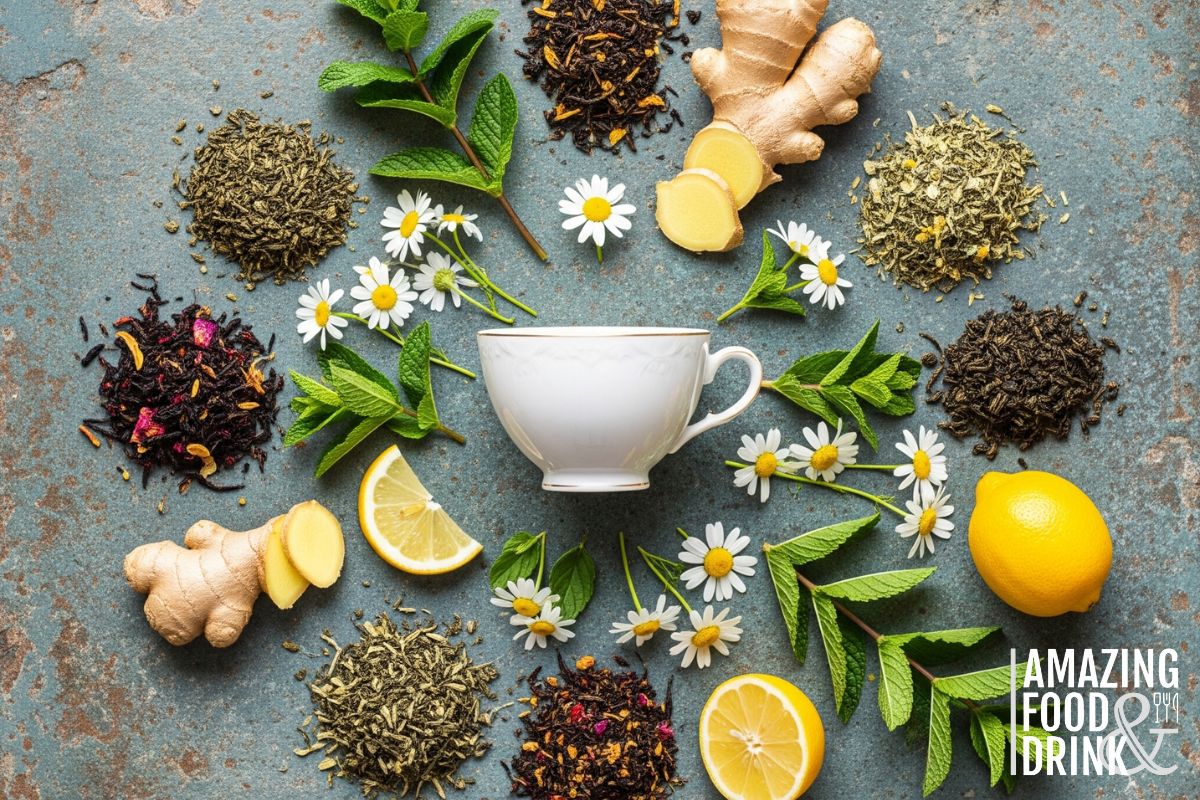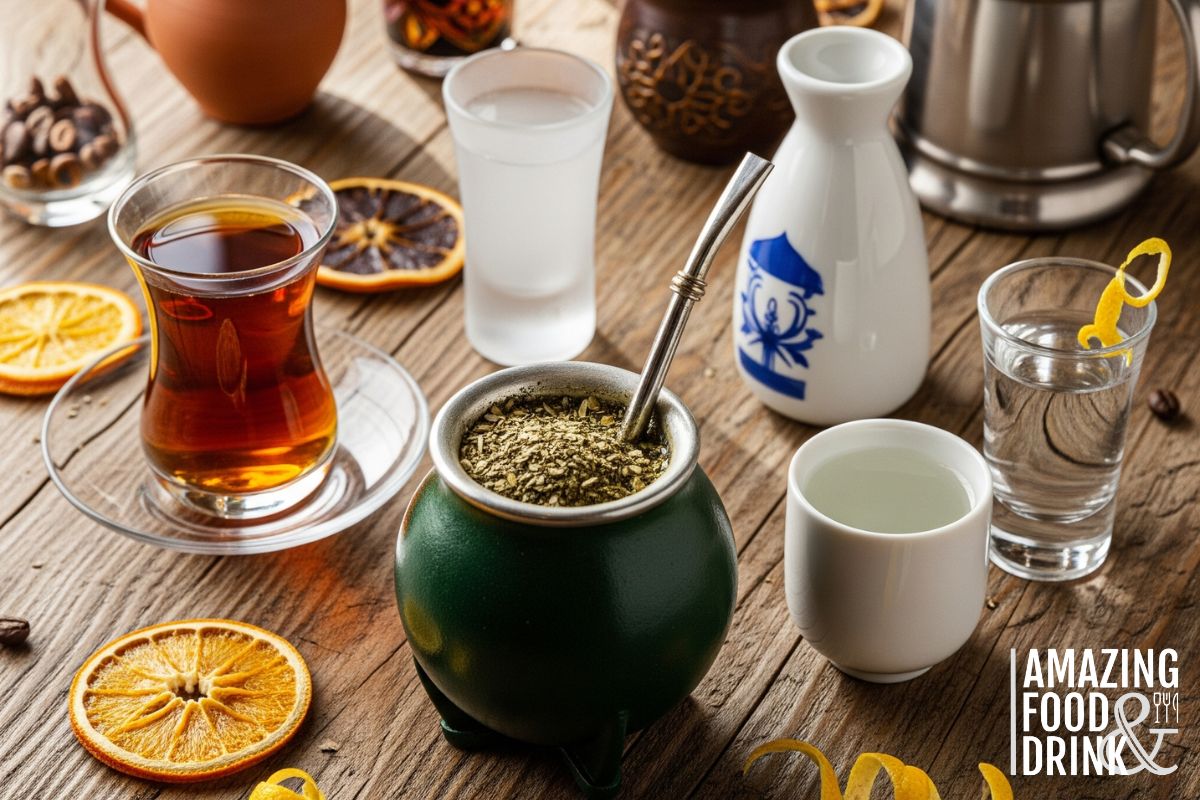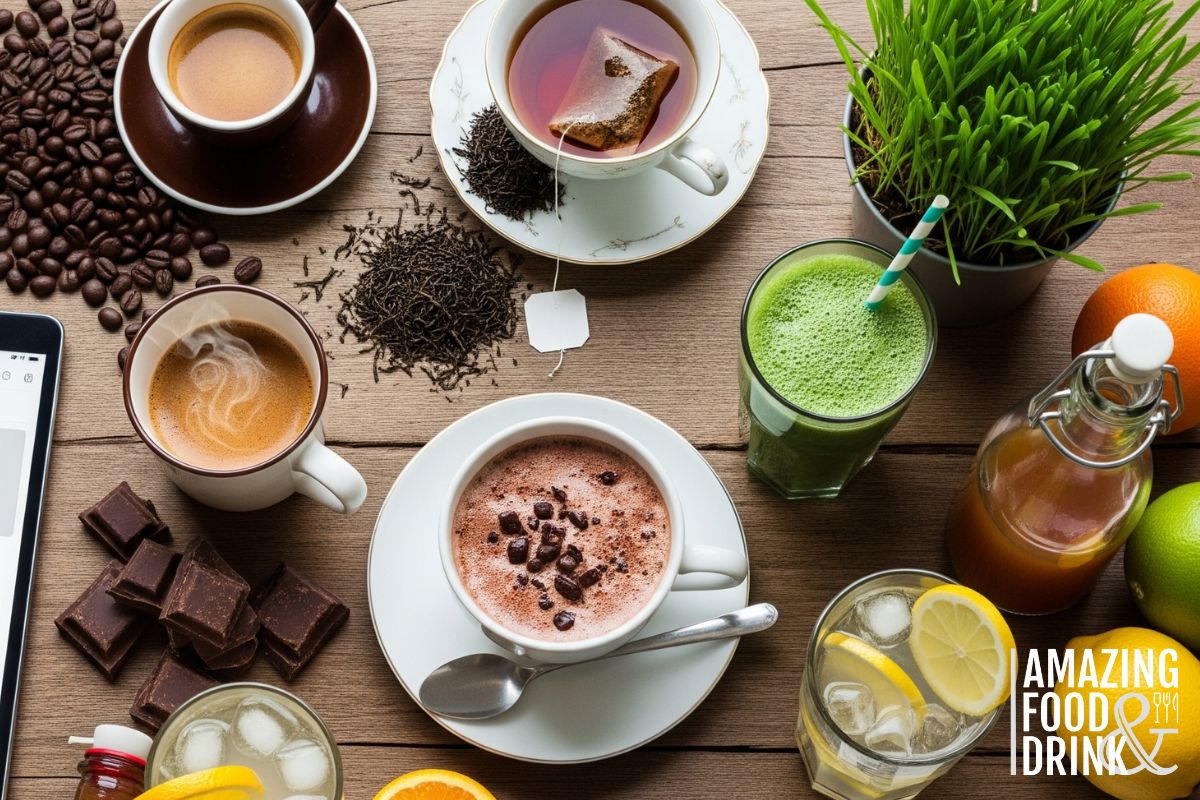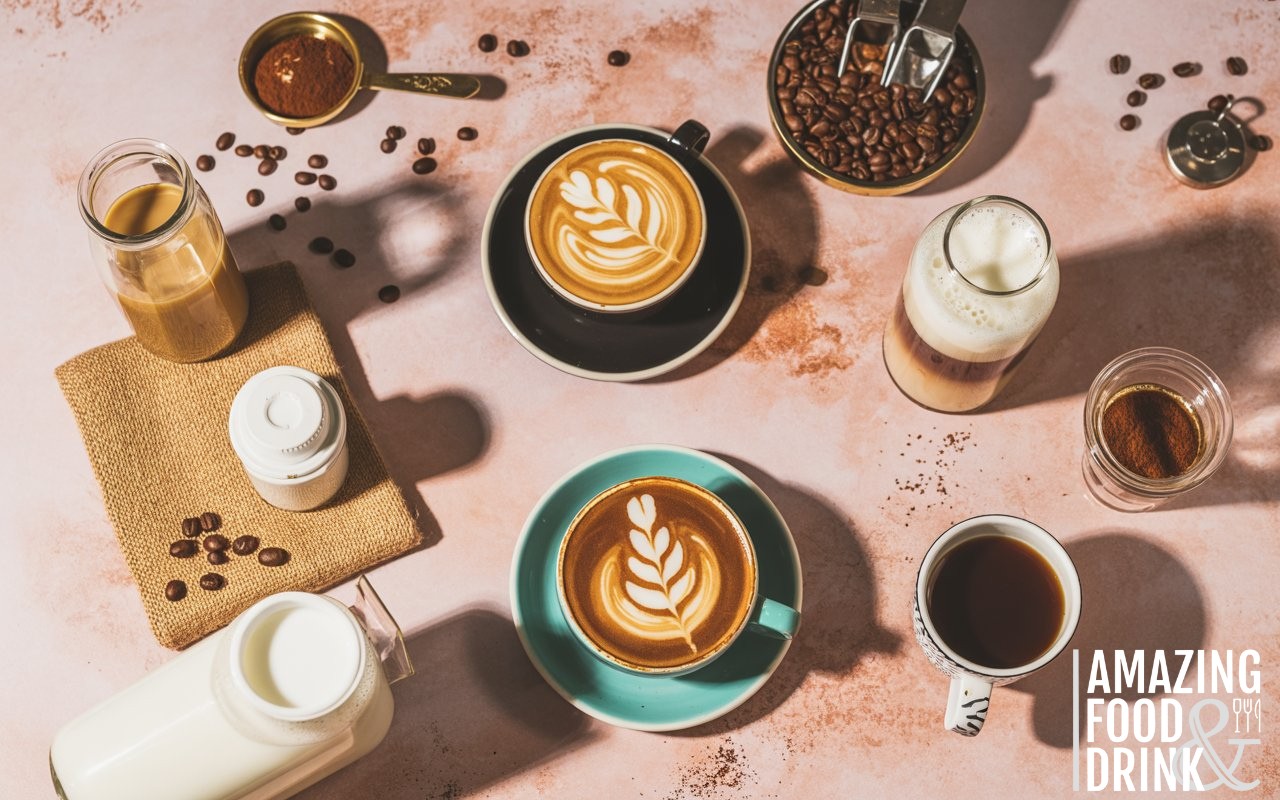From the rolling hills of Assam to your morning cuppa, understanding how Tea is made reveals the fascinating journey behind Britain’s most beloved beverage. The tea manufacturing transforms simple leaves into the complex flavours we cherish daily.
Whether you’re curious about how your favourite English Breakfast reaches your teacup or wondering about the differences between tea types, this comprehensive guide explores every step. We’ll uncover the secrets behind how Tea is made, from ancient Chinese origins to modern British blending expertise.
This detailed exploration covers the five essential steps of tea production, different tea types, and the remarkable history that brought Tea from Chinese emperors to British afternoon tea tables.
Table of Contents
What Is Tea? Types and Origins

Tea originates from the Camellia sinensis plant, first cultivated in ancient China over 4,000 years ago. Today, this remarkable plant produces all true teas consumed worldwide, including the robust blends that define British tea culture.
Basic vs Herbal vs Blended Tea
Understanding how Tea is processed begins with recognising the three main categories:
Basic Tea: Refers to pure beverages made exclusively from Camellia sinensis leaves. These unblended teas form the foundation of all tea manufacturing.
Herbal tea: Isn’t Tea at all; it’s any herb or spice infused in hot water. Popular varieties include chamomile, peppermint, and rooibos.
Blended Tea: Combines basic Tea with other ingredients. Famous examples include Earl Grey (black Tea with bergamot oil) and English Breakfast (a blend of Assam, Ceylon, and Kenyan teas).
The History of Tea: From Ancient China to Modern Britain
The legend of how Tea is made begins in 2737 BC when the Chinese Emperor Shen Nung accidentally discovered Tea. Whilst resting under a Camellia sinensis tree, leaves fell into his servant’s boiling water. Intrigued by the aromatic infusion, the emperor dried more leaves and created the first intentional cup of Tea.
Historical records confirm that Chinese emperors were drinking Tea by the second century AD, with detailed documentation of early tea production steps appearing centuries later. The beverage spread throughout East Asia before Dutch merchants introduced it to Europe in the mid-16th century.
Britain’s love affair with Tea began in the 17th century, eventually establishing the country as the world’s largest tea consumer per capita. Today, British tea manufacturing primarily blends imported leaves to create the robust flavours Britons adore.
Tea Manufacturing Process: 5 Essential Steps
The tea manufacturing process transforms fresh Camellia sinensis leaves into the familiar dried pellets we brew. Each step in processing Tea critically affects the final flavour, aroma, and colour. Here’s how the tea production steps work:
Step 1: Withering (Drying the Leaves)
Image Prompt: Tea workers spreading fresh green tea leaves on large bamboo trays under filtered sunlight in a tea plantation, with some leaves being moved to indoor withering racks in the background.
Withering begins immediately after harvest and involves both solar and indoor withering. Fresh leaves are first exposed to indirect sunlight, which kicks off the oxidation process as chlorophyll breaks down. This crucial step in making Tea typically lasts 2-4 hours, depending on weather conditions.
Indoor withering follows, where leaves are moved to controlled environments for 6-12 hours. During this phase, moisture evaporates from the leaves while enzymes continue their work. Proper withering is essential; too little results in bitter Tea, while over-withering produces weak flavours.
Step 2: Disruption (Bruising Process)
Disruption, also called bruising, accelerates oxidation by breaking down leaf cell walls. Traditional methods involve rolling leaves by hand, but modern tea manufacturing uses rotating wooden drums that gently tear the leaves.
This mechanical action serves two purposes: it allows oxygen to penetrate deeper into leaf tissues and releases remaining moisture that would otherwise create bitterness. The disruption stage typically lasts 30-90 minutes, depending on the desired tea type.
Step 3: Fixation (Stopping Oxidation)
Fixation is perhaps the most critical step in creating different tea types. This process stops oxidation at precisely the right moment, anywhere from 10% to 100%, depending on whether you’re making green, oolong, or black Tea.
Leaves are heated to 180-200°C for 10-15 minutes in rotating dryers. The heat deactivates enzymes responsible for oxidation, locking in the desired flavour profile. Master tea producers consider this step an art form, as timing determines the final product’s character.
Step 4: Crushing (Creating Pellets)
After fixation, leaves must be shaped into the familiar pellets or ‘grades’ that consumers expect. Modern tea production uses leaf kneading machines and rolling presses to create uniform sizes.
The crushing process serves multiple purposes: it increases surface area for better flavour extraction, creates consistent brewing characteristics, and enables proper packaging. Different crushing techniques produce various grades, from whole leaf teas to the fine particles in tea bags.
Step 5: Firing (Final Drying)
Firing completes the tea manufacturing process by removing all remaining moisture. Tea pellets are heated to 180°C in large ovens for 45-60 minutes, reducing the moisture content to just 2-3%.
This final step ensures long shelf life whilst intensifying flavours developed during previous stages. Properly fired Tea can maintain quality for 2-3 years when stored correctly, making global distribution of British Tea blends possible.
Tea Manufacturing Equipment & Machinery
Understanding how Tea is made requires knowledge of the specialised equipment used in commercial production. Modern tea manufacturing relies on sophisticated machinery to replicate and enhance traditional hand-processing methods.
Essential Tea Processing Equipment
Commercial tea manufacturing relies on specialised machinery designed to handle large volumes whilst maintaining the precise control necessary for quality tea production. Each piece of equipment corresponds to specific steps in how tea is made, from initial leaf processing to final preparation for packaging.
Withering Troughs: Large, ventilated containers where fresh leaves undergo controlled drying. Modern systems feature adjustable airflow and temperature controls to ensure consistent withering across different weather conditions.
Rolling Machines: These replace traditional hand-rolling, using adjustable pressure to break down leaf cells without over-crushing. CTC (Crush, Tear, Curl) machines create smaller particles for tea bags, whilst orthodox rollers maintain whole leaf integrity.
Fermentation Chambers: Climate-controlled rooms where oxidation occurs at precise temperatures (20-25°C) and humidity levels (90-95%). These chambers enable tea masters to achieve consistent oxidation levels regardless of external conditions.
Firing Ovens: Industrial dryers that remove final moisture content whilst preserving flavour compounds. Modern ovens feature precise temperature control and automated feeding systems for consistent results.
Sorting Machines: Automated systems that grade finished Tea by particle size using vibrating screens and air currents. This ensures uniform quality within each grade category.
Artisanal vs Industrial Processing
Traditional tea gardens still employ hand-processing methods for premium teas, where experienced workers judge quality by touch, sight, and smell. However, most commercial tea production relies on machinery to achieve the volume and consistency required for global distribution.
The choice between artisanal and industrial methods significantly impacts how Tea is made, with hand-processed teas often commanding premium prices due to their labour-intensive production and unique character profiles.
Seasonal Harvesting & Its Impact on Processing

How Tea is made varies significantly depending on when the leaves are harvested. Seasonal variations affect leaf quality and require adjustments to processing methods to achieve optimal results.
First Flush (Spring Harvest)
Spring’s first tender leaves produce the most delicate teas, requiring gentle processing to preserve their subtle flavours. First flush teas undergo shorter withering periods and minimal disruption to maintain light, floral characteristics.
Processing first flush leaves demands exceptional skill, as over-processing can destroy the delicate compounds that make these teas prized by connoisseurs. The shorter growing season also means limited quantities, contributing to higher prices.
Second Flush (Summer Harvest)
Summer leaves are more mature and robust, allowing longer processing times and higher oxidation levels. These leaves produce the full-bodied teas favoured in British blends, with their ability to maintain strength when mixed with milk.
Second flush processing typically involves extended withering and disruption phases, as the mature leaves can withstand more intensive handling whilst developing the complex flavours characteristic of premium black teas.
Monsoon and Autumn Harvests
Later harvests produce leaves with different characteristics, often used for commercial blends rather than premium single-estate teas. Processing methods may be adjusted to compensate for varying moisture content and leaf maturity.
Understanding seasonal variations is crucial for tea masters, who must adapt processing techniques throughout the year to maintain consistent quality standards while maximising each harvest’s unique characteristics.
5 Types of Tea Explained
Understanding how Tea is made reveals why different processing methods create distinct tea types. All true teas come from the same Camellia sinensis plant, but varying oxidation levels during tea production steps create unique characteristics. Learning how Tea is made helps explain why black Tea tastes so different from green Tea despite sharing the same origin.
Black Tea (Most Popular in the UK)

Black Tea dominates British tea consumption, representing over 80% of Tea drunk in the UK. This fully oxidised Tea (100% oxidation) undergoes the complete manufacturing process, creating its characteristic dark colour and robust flavour.
Popular British black tea blends include:
- English Breakfast: A robust blend of Assam, Ceylon, and Kenyan teas
- Earl Grey: Black Tea flavoured with bergamot oil
- Yorkshire Tea: A strong blend designed for hard water areas
- PG Tips: Britain’s best-selling tea brand
The extended oxidation process of making black tea develops complex flavours while removing bitterness. Unsweetened black Tea contains no calories but provides antioxidants that may help reduce cholesterol and improve heart health.
Green Tea (Low Oxidation)

Green Tea undergoes minimal oxidation (5-10%), preserving most of its natural antioxidants and chlorophyll. Green tea production involves immediate heating after harvest to prevent oxidation and maintain the leaves’ green colour and grassy flavour.
How green tea is processed differs significantly from how black tea is manufactured. Leaves are quickly heated through steaming (Japanese method) or pan-firing (Chinese method) immediately after harvest, then dried without the extensive oxidation period.
Green Tea’s popularity in Britain has grown significantly, with many choosing it for potential health benefits, including metabolism support and antioxidant content. However, scientific evidence for dramatic weight loss claims remains limited.
Oolong Tea (Partially Oxidised)

Oolong tea represents the middle ground in manufacturing, with oxidation levels ranging from 8% to 80%. This partial oxidation creates complex flavour profiles combining characteristics of both green and black teas.
The unique aspect of making oolong tea involves carefully controlling oxidation. Tea masters repeatedly alternate between withering and disruption stages, gradually building oxidation levels while maintaining specific flavour notes.
Traditional oolong production requires exceptional skill, as processors must judge optimal oxidation levels by appearance, aroma, and touch. This artisanal approach makes high-quality oolongs among the most expensive teas globally.
White Tea (Minimal Processing)

White Tea uses only young buds and unopened leaves, harvested before they fully develop. Named for the fine white hairs covering these buds, white Tea undergoes the least processing of all tea types.
How white Tea is made involves minimal human intervention: buds are simply withered and dried without disruption or significant oxidation. This gentle approach preserves maximum antioxidant content whilst creating subtle, delicate flavours.
The minimal tea production steps required for white Tea make it expensive, as harvesting young buds requires precise timing and careful handling. However, its high antioxidant content and refined taste attract discerning tea drinkers worldwide.
Yellow Tea (Rare Chinese Variety)

Yellow Tea remains largely unknown outside China due to its complex and costly production method. This rare variety involves an additional step called ‘sealed yellowing’ between fixation and final drying.
The unique process of making yellow tea involves wrapping partially processed leaves in cloth and allowing them to steam gently. This creates slow, controlled oxidation, developing the characteristic yellow colour and smooth, creamy flavour.
Few tea gardens produce yellow Tea commercially due to the labour-intensive process and specialist knowledge required. This rarity makes authentic yellow Tea among the most expensive teas available.
Tea Quality Grading System
Understanding how Tea is made includes learning the international grading system, determining quality and price. Tea grading focuses on leaf size, appearance, and processing method, not flavour quality alone.
Whole Leaf Grades (Highest Quality)
- FTGFOP (Finest Tippy Golden Flowery Orange Pekoe): The highest grade for black Tea, featuring whole leaves with golden tips from young buds. These teas command premium prices due to careful processing and exceptional appearance.
- TGFOP (Tippy Golden Flowery Orange Pekoe): High-quality whole leaf tea with some golden tips, representing excellent processing standards and careful handling throughout manufacturing.
- GFOP (Golden Flowery Orange Pekoe): Good quality whole leaf tea with occasional golden tips, offering excellent value for premium loose-leaf teas.
Broken Leaf Grades (Medium Quality)
- FBOPF (Flowery Broken Orange Pekoe Fannings): Smaller pieces of high-quality leaves, ideal for strong breakfast blends that maintain character when mixed with milk.
- BOPF (Broken Orange Pekoe Fannings): Standard broken grade used in many commercial blends, providing good strength and colour for everyday drinking.
Fannings and Dust (Commercial Grades)
- Pekoe Fannings: Small leaf particles perfect for tea bags, offering quick brewing and strong colour essential for mass-market teas.
- Dust Grade: The finest particles are used primarily in tea bags for instant strength and colour. Despite the name, dust grade tea from quality estates can produce excellent everyday cups.
Quality Assessment Beyond Grading
Professional tea tasters evaluate five key aspects: appearance (leaf size and colour), aroma (dry leaf and wet leaf scents), flavour (taste profile), colour (liquor brightness), and mouthfeel (body and astringency).
Understanding these grades helps consumers make informed choices, as higher grades generally indicate more careful processing and handling throughout the manufacturing process.
Regional Processing Differences

How Tea is made varies significantly across different tea-producing regions, with each area developing unique processing methods suited to local climate, leaf characteristics, and cultural preferences.
Chinese Processing Methods
China’s diverse tea regions employ varied processing techniques, from the delicate pan-firing method for green teas to the traditional oolong oxidation methods. Chinese processors often rely on centuries-old artisanal techniques passed down through generations.
Pan-firing: Used primarily for green tea production, this method involves heating fresh leaves in large woks to halt oxidation immediately after harvest. The technique requires exceptional skill to prevent scorching whilst achieving uniform heating.
Traditional Rolling: Chinese processors often roll leaves by hand or using traditional wooden tools, creating the distinctive twisted shapes characteristic of many Chinese teas.
Indian Processing Innovations
India pioneered the CTC (Crush, Tear, Curl) method in the 1930s, revolutionising commercial tea production. This process creates uniform, small particles ideal for strong breakfast blends that brew quickly and maintain flavour with milk.
High-altitude Processing: Darjeeling’s high-altitude gardens require adjusting processing methods for lower temperatures and varying humidity levels. The cooler climate allows for longer withering periods, developing the complex flavours Darjeeling is famous for.
Assam Techniques: The humid climate necessitates controlled indoor withering to prevent over-fermentation. Modern Assam gardens use sophisticated climate control systems to maintain consistency despite challenging weather conditions.
Sri Lankan Precision Methods
Ceylon tea processing emphasises precision and consistency, with many gardens using advanced monitoring systems to track oxidation levels throughout processing. The island’s varied elevations require different approaches for low-grown, mid-grown, and high-grown teas.
High-grown Processing: Estates above 1,200 metres utilise cooler temperatures and increased UV exposure to develop the bright, citrusy characteristics of Ceylon high-grown teas.
Kenyan Modern Approaches
Kenya’s relatively young tea industry has embraced modern processing technology, focusing on efficiency and consistency. Most Kenyan Tea undergoes CTC processing optimised for international blend requirements.
These regional differences in how Tea is made contribute to the diverse flavour profiles available to consumers, with each method optimised for local growing conditions and market demands.
Storage & Packaging Methods

The final stages of tea production involve proper storage and packaging to preserve quality from the factory to the consumer. These crucial steps determine whether Tea maintains its flavour and aroma during distribution and storage.
Immediate Post-Processing Storage
After firing, Tea must be cooled completely before packaging to prevent condensation that could lead to mould or quality deterioration. Commercial facilities use large cooling chambers with controlled airflow to reduce the temperature uniformly.
- Moisture Control: Finished Tea contains 2-3% moisture content, which must be maintained throughout storage. Higher moisture levels can cause deterioration, whilst lower levels may result in dusty Tea that loses flavour compounds.
- Temperature Management: Tea storage areas maintain temperatures between 15 °c and 20°C to preserve volatile oils responsible for aroma and flavour. Fluctuating temperatures can cause condensation and quality loss.
Packaging Materials and Methods
- Foil-lined Packages: Premium teas often use aluminium foil linings that provide excellent barriers against moisture, light, and oxygen – the three main enemies of tea quality.
- Tea Bags: Modern tea bag materials include paper, silk, and biodegradable options. The bag material must allow proper water circulation while effectively containing tea particles.
- Bulk Packaging: Commercial tea for blending is often stored in large, lined containers that protect against contamination while allowing easy handling during blending operations.
Quality Preservation Techniques
- Nitrogen Flushing: Some premium packagers replace air in packages with nitrogen gas, eliminating oxygen that can cause staleness and flavour deterioration.
- Vacuum Sealing: High-end teas may be vacuum-sealed to remove air and extend shelf life, though this method requires careful handling to prevent crushing delicate leaves.
Understanding proper storage and packaging is essential for maintaining the quality achieved during processing and ensuring consumers receive tea that reflects the care taken during manufacturing.
Sustainability in Tea Manufacturing

Modern tea manufacturing increasingly focuses on sustainable practices, addressing environmental concerns while maintaining quality standards. Understanding how Tea is made today includes recognising the industry’s commitment to environmental responsibility.
Organic Processing Methods
Organic tea manufacturing eliminates synthetic chemicals throughout processing, relying on natural pest control and soil management methods. This approach requires more labour-intensive monitoring but produces Tea free from chemical residues.
- Natural Pest Control: Organic gardens use beneficial insects, companion planting, and natural deterrents instead of pesticides, requiring careful ecosystem management during growing and processing.
- Chemical-free Equipment: Processing machinery in organic facilities must be thoroughly cleaned to prevent contamination from conventional teas, often requiring dedicated equipment and facilities.
Energy Efficiency Improvements
- Solar Drying: Some modern facilities incorporate solar drying systems for the firing stage, reducing fossil fuel consumption whilst maintaining precise temperature control.
- Biomass Fuel: Tea processing waste, including stems and lower-grade leaves, can fuel firing ovens, creating a circular system that reduces external energy requirements.
- Water Conservation: Advanced processing facilities recycle water for cleaning equipment and cooling systems, significantly reducing water consumption.
Waste Reduction Initiatives
- Composting Programmes: Tea processing waste makes excellent compost for tea gardens, returning nutrients to the soil and reducing landfill waste.
- Packaging Innovation: Biodegradable tea bags and recycled packaging materials help reduce environmental impact whilst maintaining product protection.
Fair Trade Certification
Fairtrade tea manufacturing ensures workers receive fair wages and work in safe conditions while supporting community development in tea-growing regions. These programmes often include environmental protection requirements alongside social standards.
Sustainable practices in tea production protect the environment and often improve tea quality by promoting healthier growing conditions and more careful processing methods.
Health Benefits of Different Tea Types
Each tea type offers unique health benefits based on processing methods and antioxidant retention:
Black Tea Benefits:
- Rich in theaflavins and thearubigins
- May reduce cholesterol levels
- Supports cardiovascular health
- Contains moderate caffeine for alertness
Green Tea Benefits:
- High in catechins, particularly EGCG
- Powerful antioxidant properties
- May support metabolism
- Lower caffeine content than black Tea
White Tea Benefits:
- Highest antioxidant levels
- Minimal processing preserves natural compounds
- Gentle on the digestive system
- Subtle flavour appeals to sensitive palates
Oolong Tea Benefits:
- Balanced antioxidant profile
- May help regulate blood sugar
- Traditional Chinese medicine applications
- Complex flavours aid mindful drinking
Tea in Britain: From Colonial Import to Cultural Institution

Britain’s relationship with Tea extends far beyond simple beverage consumption. UK tea manufacturing primarily blends imported leaves to create distinctly British flavour profiles suited to local water conditions and taste preferences.
Major British tea companies like Twinings, Tetley, and Yorkshire Tea have perfected blending techniques for regional water hardness variations. This expertise in how British Tea is made ensures consistent flavour whether you’re brewing in soft Scottish water or hard London water.
The afternoon tea tradition, established in the 1840s by the Duchess of Bedford, elevated Tea from a mere refreshment to a cultural ceremony. Today, proper afternoon tea service remains a quintessentially British experience, showcasing how tea manufacturing innovations support cultural traditions.
Understanding how Tea is made reveals the remarkable craftsmanship behind every cup, from the careful oxidation control that creates different tea types to the blending expertise that defines British tea culture. This ancient process, refined over thousands of years, continues to bring people together through the simple pleasure of a perfectly brewed cuppa.
FAQs
1. How long does it take to make Tea from leaf to packet?
The complete tea manufacturing process takes 24-48 hours from fresh leaf harvest to packaged Tea, depending on the type and oxidation level required. Black Tea takes the longest due to full oxidation, whilst green Tea can be processed within 24 hours.
2. What’s the difference between CTC and orthodox tea processing?
CTC (Crush, Tear, Curl) produces smaller particles that are ideal for tea bags and quick brewing, whilst orthodox processing maintains whole leaves for loose-leaf tea with better flavour complexity. Most British breakfast blends use CTC processing for convenience and strength.
3. Why is tea processed rather than fresh?
Processing enhances flavour, aroma, and shelf life through controlled oxidation. Fresh leaves are bitter and lack the complex flavours developed during manufacturing. Processing also enables long-term storage and global distribution.
4. Can you make Tea at home from tea plants?
Yes, but it requires careful timing and temperature control. Home processing involves withering fresh leaves, rolling to bruise them, controlling oxidation time, then drying thoroughly. However, achieving commercial quality requires experience and proper equipment.
5. How does water quality affect tea brewing?
Water mineral content significantly impacts tea flavour. Hard water (high in calcium and magnesium) can make tea taste flat, whilst very soft water may produce overly strong, bitter results. British tea blends are formulated explicitly for local water conditions.



